Termination letter template for employee
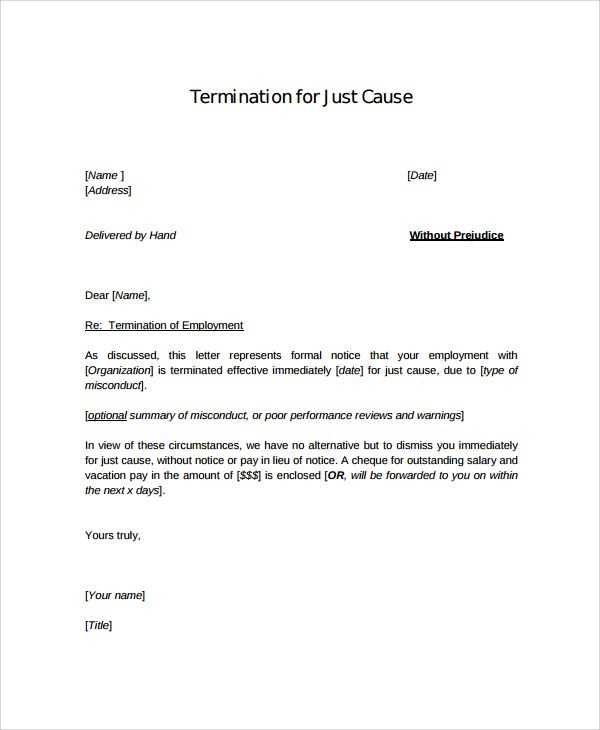
When drafting a termination letter, it’s key to stay clear, direct, and respectful. Begin by stating the purpose of the letter in a straightforward manner. Make sure to include the date of termination, as well as any other important dates, such as the last working day or any applicable notice period.
Use concise language throughout the letter. Specify the reason for termination, whether it’s due to performance issues, company restructuring, or other valid reasons. If applicable, mention any severance packages or benefits the employee is entitled to, such as unused vacation days or retirement benefits. This will help ensure clarity on both sides and avoid confusion.
It’s also helpful to provide the employee with instructions on returning company property, like keys, equipment, or documents. If relevant, mention any ongoing responsibilities, such as completing final paperwork or undergoing an exit interview. Finish with a statement offering assistance in their future job search or referencing any outplacement services provided by the company.
Remember to sign the letter, using a professional tone, and make sure to keep a copy for your records. This formalizes the termination process and protects both the employer and employee in case of future disputes.
How to Structure a Termination Letter
Begin by addressing the employee by name at the top of the letter. State clearly the purpose of the letter, using direct language to avoid any confusion. For example, “We regret to inform you that your employment with [Company Name] is terminated effective [Date].” Avoid any vague language to ensure the message is straightforward.
Include Relevant Details
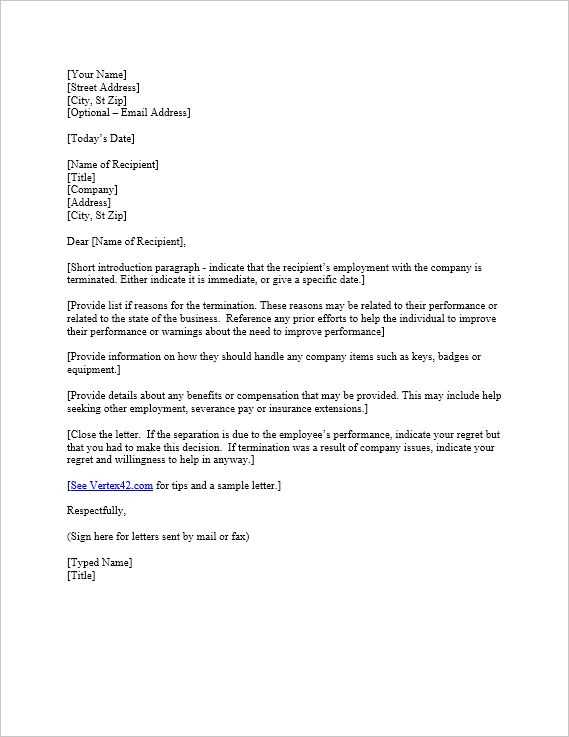
Provide specifics regarding the reason for termination, if appropriate. If the reason involves performance, you can mention relevant feedback or instances where expectations were not met. If termination is based on company policies, reference the specific policy or rule. Keep this section factual and neutral.
Outline Final Steps
Clearly explain any next steps the employee needs to take. This includes information on returning company property, receiving their final paycheck, and any benefits or severance details. Make sure the employee understands their responsibilities post-termination. This ensures there is no ambiguity in the process.
Provide Contact Information
Provide a point of contact for any questions. Offer assistance with the transition, if appropriate, such as help with unemployment claims or final paperwork. Make sure the contact details are clear and easy to find.
| Section | Details |
|---|---|
| Opening | Address employee by name and state the purpose of the letter clearly. |
| Reason for Termination | Explain the reason for termination with factual information, if necessary. |
| Final Steps | Outline necessary actions, such as returning property and receiving final payments. |
| Contact Information | Provide a point of contact for further questions or clarification. |
Reasons for Terminating an Employee
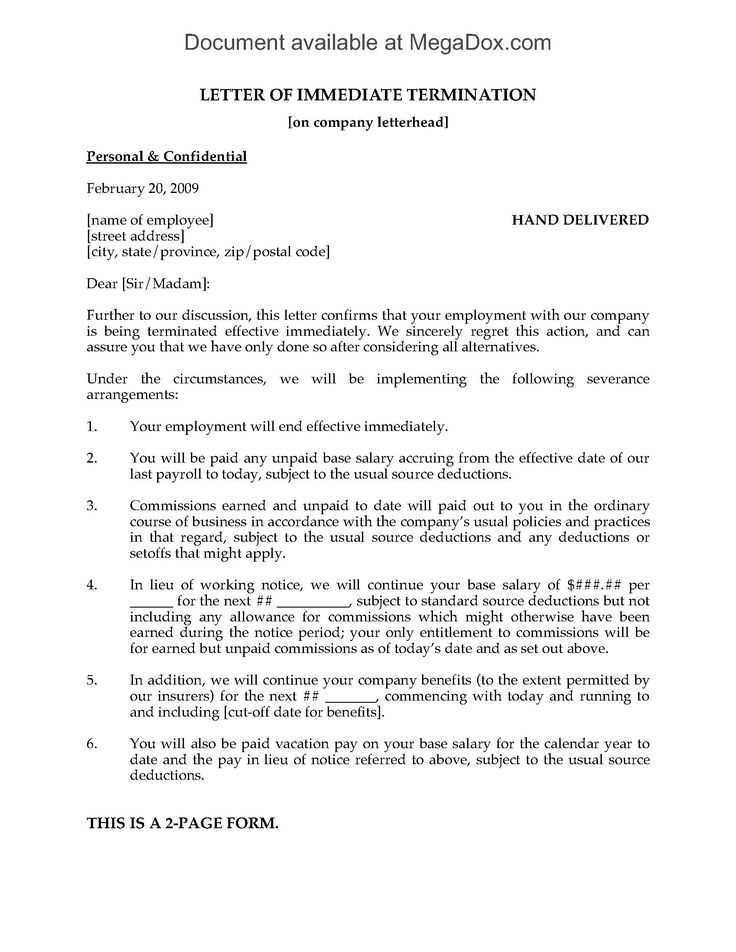
Performance issues are one of the most direct reasons for terminating an employee. If an individual consistently fails to meet job expectations despite clear feedback and support, it can lead to termination. It’s crucial to document instances where performance doesn’t align with company standards.
Behavioral problems such as dishonesty, harassment, or insubordination can also justify dismissal. These actions undermine the workplace environment and often create conflicts that disrupt productivity. When these behaviors persist after warnings, termination becomes a necessary step.
Attendance issues are another common reason for termination. Excessive absenteeism, tardiness, or leaving early without a valid excuse can severely impact team dynamics and operations. An employee’s lack of consistency in attendance should be addressed promptly to avoid escalation.
Violating company policies or engaging in unethical practices is a clear reason for dismissal. Employees must adhere to established guidelines, and any deliberate breach can result in immediate termination. In these cases, ensuring clear communication of policies is critical to avoid confusion.
Lastly, financial constraints or organizational restructuring might lead to layoffs. If a company faces budget cuts, downsizing, or reorganization, the need for certain positions may no longer exist. This is often an involuntary termination, but proper communication and support are key to handling these transitions smoothly.
Best Practices for Professional Tone
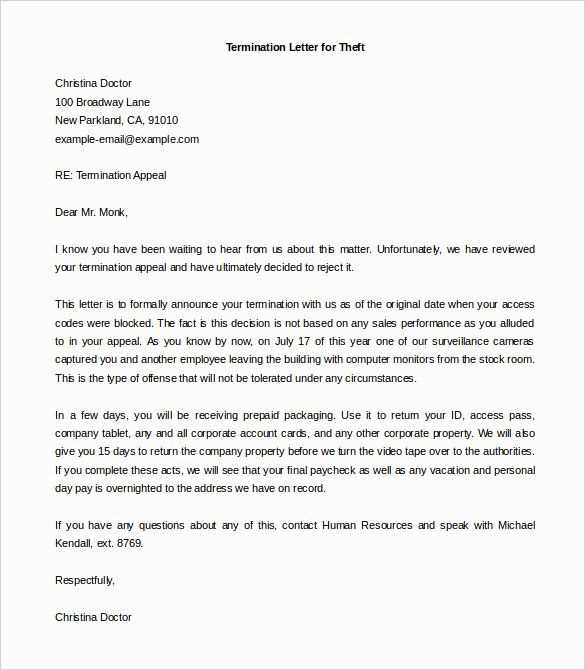
Maintain clarity and directness. Be straightforward and use simple language. Avoid jargon that might confuse the reader. Your message should be clear without unnecessary complexity.
Be respectful in all statements. Even if the termination is due to performance issues, keep the tone neutral and respectful. Avoid negative language that could escalate tensions.
Stay Objective
Focus on facts and avoid making personal judgments. Clearly explain the reason for the termination without discussing emotions or opinions. For instance, instead of saying “You were not performing well,” say “The performance targets were not met according to the established standards.”
Avoid Ambiguity
Be as specific as possible. Ambiguity can lead to confusion or misinterpretation. Always reference clear dates, actions, and expectations. For example, instead of stating “you missed several deadlines,” indicate “you missed the deadlines set for January 5th and January 12th.”
Legal Considerations in a Termination Letter
Ensure the termination letter includes clear justification for the decision. This protects the company from potential legal claims of wrongful dismissal. Specify whether the termination is due to performance issues, misconduct, or other factors, and provide specific examples when applicable.
Check local labor laws to confirm if any specific language or procedures must be included. Some jurisdictions require that certain rights, like severance pay or benefits continuation, be addressed directly in the termination letter.
Non-Discriminatory Language
Use neutral, non-discriminatory language. Do not refer to protected characteristics such as race, gender, or disability in the termination process unless it is directly relevant and documented. Discriminatory language can lead to claims of unfair dismissal or discrimination lawsuits.
Severance and Benefits
If the employee is entitled to severance pay or continuation of benefits, clearly outline these details. Include how and when the payments will be made, and mention any applicable conditions, such as the return of company property.
Include a statement that the employee may be entitled to review the contents of their file and receive assistance with finding new employment if required. This can mitigate the risk of legal challenges based on claims of inadequate support post-termination.
Finally, ensure that the letter is signed by an authorized person in the company, such as a manager or HR representative, to confirm its validity.
Notifying the Employee of Final Pay and Benefits
Clearly communicate the details of the employee’s final pay and benefits in writing. This notification should include the exact amount the employee will receive, including any unpaid wages, accrued vacation days, or bonuses. Provide a breakdown of these amounts, specifying any deductions or adjustments made to the final payment.
Clarifying Payment Schedule
Ensure the employee knows when they can expect to receive their final payment. If the company typically processes payroll on a certain schedule (e.g., biweekly or monthly), inform the employee whether their final pay will be included in the upcoming pay cycle or processed separately. If there are any delays, explain the reason and provide a specific timeline.
Explaining Continued Benefits
If the employee is eligible for benefits continuation, such as health insurance, explain how long these benefits will remain active and whether the employee needs to take any steps to extend or convert their coverage. Include details about the COBRA process, if applicable, and the associated costs. It’s essential to clearly state any benefits the employee will lose upon separation and how they can manage or replace them after their departure.
Post-Termination Communication and Next Steps
After an employee’s termination, it’s important to communicate clearly about the next steps. This helps avoid confusion and ensures a smooth transition for both the employer and the employee.
Clarify the Terms of Separation
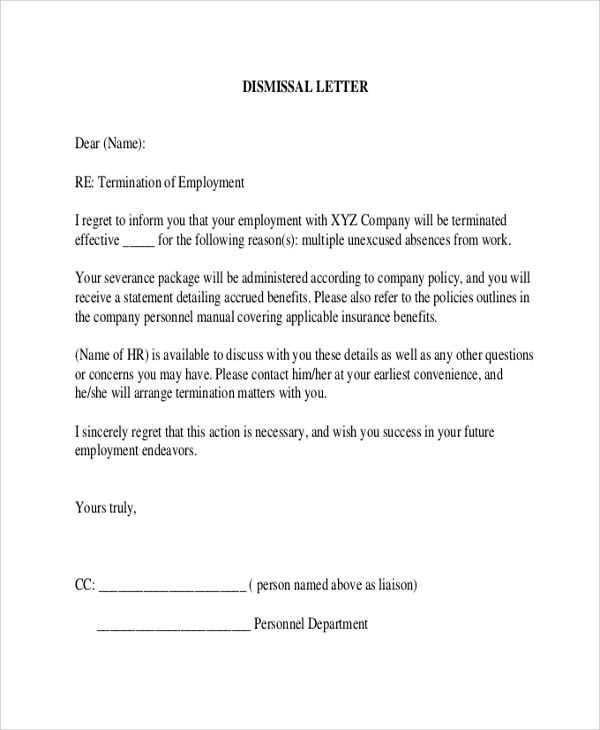
- Provide written confirmation of the termination date and any severance or benefits details.
- Explain the process for returning company property, such as keys, equipment, or documents.
- Outline the status of any ongoing projects or responsibilities the employee needs to hand over.
Provide Information on Final Pay and Benefits
- State when the final paycheck will be issued, and whether it will include unused vacation or sick days.
- Clarify what happens to the employee’s health benefits or retirement plans, if applicable.
- Offer contact details for HR to handle any questions about these matters.
Ensure all communication is professional and supportive to maintain a positive relationship, even after the employment ends. This can help mitigate any potential legal issues or negative feelings.